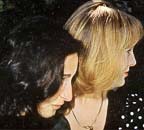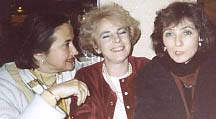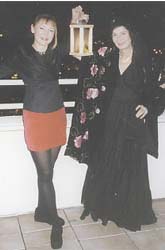|
Christa et Sam Fuller
 
If I put Christa before Sam, which might surprise fans of the moviemaker of Shock Corridor, it’s because I knew her first through an American agent and because she introduced me immediately to a lot of the exclusive clique of the well-known and the less famous of the little kingdom of Hollywood. With Christa, in the villa on the corner of 7628 Woodrow Wilson Drive, we discussed the work of philosopher Derrida, in the sunny glints of a sublime swimming pool, where photographer Gilles Larrain. gave us a massage. Then, Sam encouraged me to write the synopsis of the « Imaginary Memories of Countess Bathory” and he dreamt up the title for a film : Bloody Bath for Bathory.
Gilberte Furstenberg
 What would my journeys in the States be if Gilberte had not existed ? Would I have stayed in this hotel wretched and strange in the most dangerous area of Washington where I had been the first time, because of a How To Survive Most Cheaply in the States agenda? There, indeed, Gilberte (at the time, correspondent for the Express ), filled with dread, captured me and whisked me away to her lovely mansion in Forrest Hill. Could I have learned to speak English as fluently if she had not made me repeat my lessons, every day, while baking her bread in the oven? Could I have been able to shoot my first TV film on Life Magazine, Life and Death of a Journal and to make an interview with Anderson oor Ralph Nader without these crammed scraps of English? When she left Washington for Boston, she introduced me to the people and customs of MIT (Massachussetts Institute of Technology), where she taught French. Later, at the MIT, I published the two books on Biotechnology: Strategies for Life, that I wrote, and The Science of Mind, which I directed. She also gave me the idea to take up a new career in multimedia, a field in which she was extremely knowledgeable, having won prizes for her remarkable works on how to learn a language. I thank her for having been at once one of my guardian angels, one of the most faithful friends, and of the most enriching, through the example of humility and hard work that she still provides. What would my journeys in the States be if Gilberte had not existed ? Would I have stayed in this hotel wretched and strange in the most dangerous area of Washington where I had been the first time, because of a How To Survive Most Cheaply in the States agenda? There, indeed, Gilberte (at the time, correspondent for the Express ), filled with dread, captured me and whisked me away to her lovely mansion in Forrest Hill. Could I have learned to speak English as fluently if she had not made me repeat my lessons, every day, while baking her bread in the oven? Could I have been able to shoot my first TV film on Life Magazine, Life and Death of a Journal and to make an interview with Anderson oor Ralph Nader without these crammed scraps of English? When she left Washington for Boston, she introduced me to the people and customs of MIT (Massachussetts Institute of Technology), where she taught French. Later, at the MIT, I published the two books on Biotechnology: Strategies for Life, that I wrote, and The Science of Mind, which I directed. She also gave me the idea to take up a new career in multimedia, a field in which she was extremely knowledgeable, having won prizes for her remarkable works on how to learn a language. I thank her for having been at once one of my guardian angels, one of the most faithful friends, and of the most enriching, through the example of humility and hard work that she still provides.
Martine Gallois de Roquette
 Niece of General Gallois, De Gaulle’s initiator of French nuclear power policy and a friend of my father, Martine (left in the photo, with two other friends at the Lycée Molière, Jacqueline Dedoyard and José Geslain) has been the best friend and companion of my childhood and adolescence, rebellious, intrepid, climbing trees and playing games like car chases, as in the new wave films. A very faithful friend, with the stoic fortitude demanded by daily life, she lives today in the country (Lauraguais), but our past life at Molière, in Cassel or Heidelberg, at the Sagrada Familia Convent of Palma de Mallorca (where we enjoyed our first serenades), and time spent together today in Toulouse when I come to see her, in Paris when she is visiting the capital, consolidates an indestructible fondness for today and tomorrow. Niece of General Gallois, De Gaulle’s initiator of French nuclear power policy and a friend of my father, Martine (left in the photo, with two other friends at the Lycée Molière, Jacqueline Dedoyard and José Geslain) has been the best friend and companion of my childhood and adolescence, rebellious, intrepid, climbing trees and playing games like car chases, as in the new wave films. A very faithful friend, with the stoic fortitude demanded by daily life, she lives today in the country (Lauraguais), but our past life at Molière, in Cassel or Heidelberg, at the Sagrada Familia Convent of Palma de Mallorca (where we enjoyed our first serenades), and time spent together today in Toulouse when I come to see her, in Paris when she is visiting the capital, consolidates an indestructible fondness for today and tomorrow.
Nathalie Geshir
 Nathalie (left in the photo) was a very young girl when she gave music lessons to my daughter. She came from the east of France (Metz), and loved the piano and children, she now teaches in a school in Lorient, Bretagne, after having been teacher in the suburbs and working with the “underprivileged social classes” in Opera of Paris. Dynamic, always with new incentive ideas, she is loved by children and dogs, as she says, but also by people who feel that burns within her. Nathalie (left in the photo) was a very young girl when she gave music lessons to my daughter. She came from the east of France (Metz), and loved the piano and children, she now teaches in a school in Lorient, Bretagne, after having been teacher in the suburbs and working with the “underprivileged social classes” in Opera of Paris. Dynamic, always with new incentive ideas, she is loved by children and dogs, as she says, but also by people who feel that burns within her.
Maurice Girodias
Wickedly daring publisher in a time when one could be put in jail for the publication of erotic books, Maurice Girodias was the first to dare to publish Lolita by Nabokov, and therefore he has been defamed by Gore Vidal as " peddler of dirty books" and "merchant of smut". Girodias lived a long time in Boston and New York, and I met him the first time when I lived there, in Gilles Larrain’s loft. We saw each other again in Paris, where he bought me many, many ice creams at the very famous Berthillon in rue Saint-Louis-en-l’île. He was a wonderful friend, full of understanding, subtlety, and musing melancholy. He died in 1990. In Paris in 1953 he had founded Olympia Press and became a publisher to pursue the work of his father, Jack Kahane – who had discovered Henry Miller, Anaïs Nin, James Joyce, Lawrence Durrell and published them in the 1930s at Obelisk. He was also the first, to publish in English the work by Pauline Réage, Histoire d’O, The Naked Lunch by William S. Burroughs, and the works of such writers as Beckett, Queneau, Genêt or Bataille.
Sadek Godzabeh
One evening, a young Yugoslavian air hostess, whom I knew through friends, asked me if I’d like to be introduced to one of my readers, an affable man who, in the plane, was reading Droit d’asiles en Union Soviétique(« The Right of Asylums in the Soviet Union ») , : when my young friend said that she knew me, he invited us to a magnificent flat on the banks on the Seine, near the House of Radio. He lived there, in Iranian style, on sumptuous carpets on the floor, and presented himself as the head of the Iranian students fighting against the Shah’s system. I didn’t hide from him that I did not share his political analysis, but he dismissed my phrase out of hand and called me many times to invite me for a lunch and a chat. We had an odd relationship, without any marivaudage (we could perhaps translate it by « light-hearted banter » or by « sweet-talk » That’s in fact a very French feeling around love’s premise), and I was often asking me about the reasons for his interest. In the meantime, I became journalist at VSD. Maybe that was the reason…? He used to talk about an old man, whom he knew very well and became a close advisor, Imam Khomeiny, who lived in exile in France, at Neauphle-le-Château. The photo of the old guy was in the middle of the Champs-Elysées, on the front of the “House of Iran”, with the phrase “The man who makes the West tremble”, and my father was furious. Sadek offered many times to drive me to Neauphle for an interview. Why did I refuse so vehemently? I don’t know but I don’t regret it really. Then, I left for the West Indies, to direct an Encyclopaedia project. In a short piece in the humorous paper (but generally well informed) Canard Enchaîné, I read that Godzabeh was back in Iran in the wake of revolution, and that probably he was a double agent for the CIA and the KGB. I was never sure, but certain wooden expressions he used reminded me of the things I had heard in some of my interviews in the Soviet Union, and so maybe that was why I was so cautious. Not long after, Sadek Godzabeh (who offered me a scoop interview with former minister Hoveyda, which I refused) was killed by his political enemies in Iran.
|



